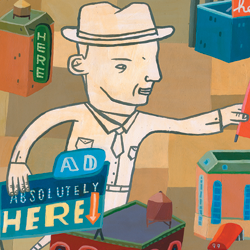|
exhibiting 101

Damage Control
Here are some tips and tricks to help you avoid exhibit damage before, during, and after the show.
Statistically speaking, your chances of never having some part of your exhibit properties damaged from the time you ship them to a show to the time they arrive at your booth space are pretty darned slim. In my 20 years on the job, I've personally encountered plenty of disasters.
For example, my client's prototype equipment rolled off the shipping dock during loading, a truck carrying my exhibit got into an accident on the way to the show, my carpet was dragged through a pool of hydraulic oil left by a leaking forklift that dissolved the glue holding our carpet fibers to its backing during transit. There was also that time a forklift jockey poked holes through my crate, subsequently turning my graphics and wall panels into Swiss cheese. Additional show-site disasters include product damage due to a leaky convention-center roof and a monitor that was knocked over and cracked before it could be mounted in my booth. Bottom line, all these exhibit-related damages and more can and do happen, and it's your responsibility as an exhibit manager not only to anticipate what could go wrong, but also to fix it when everything goes to hell in a handbasket. With that in mind, here's my advice on how to prepare for disaster and come out unscathed. Handle With Care There are steps you can take to mitigate damage to exhibits. Start by planning ahead and incorporating fail-safes during the exhibit-design phase. Since we know there are major dangers in exhibit handling during the shipping and material-handling processes, include sturdy crates or cases for shipping properties in the request for proposal for any new exhibit build. Pallets may be OK for shipping boxes of giveaways or marketing collateral, but if you're looking to protect something that could easily be damaged, you can't beat crates. Budget at least $1,000 to $1,500 per large crate (the kind that has sturdy skids bolted on to the bottom). When it comes to protecting the contents of your crates, have your crate builder insert permanent jigs, which are carpet-covered wood or plastic spacers between items to prevent contact during transit. Also have drawers or cubbyholes built in to house smaller, fragile exhibit components such as light fixtures, and use Bubble Wrap or foam sheeting like it's going out of style. After setup is done, I stow away the extra packing for rewrapping items during dismantle. To protect your carpet between shows, consider purchasing heavy-duty, liquid- and dirt-repellant bags. If those aren't in your budget, wrap your carpet in Visqueen (construction plastic) and ship it on a carpet pig – a long pallet, usually on wheels, with corner posts to hold the heavy rolls of carpet and pad in place. For exhibit graphics, use foam and/or Bubble Wrap to provide extra cushioning. I sometimes buy handy corner protectors for wrapped graphics if I'm feeling extra cautious. If you don't individually wrap each graphics panel, make sure that the hook side of the hook-and-loop fastener on the back of one panel isn't rubbing the front of the panel packed next to it. And a word to the wise about those "fragile" labels: In my experience, such labels seem to make freight a target for abuse – just as black stretch wrap around crates is supposed to hide valuable property but instead points out to thieves, "Hey, look what we're trying to hide over here!" I'd also save your money when it comes to shock sensors, which are labels that house capsules of colored liquid. The label is affixed to a box or crate, and if the container is dropped during transit, the colored liquid becomes visible through a tiny window in the capsule. Sounds cool, right? Well, it is, until you see a truck driver with a stash of new stickers in his glove box, ready to replace ruptured labels. So extra padding and a sturdy crate are your best bets for a damage-free shipment. Granted, the cost of these extra packing supplies does add up, but the way I see it, you have a choice: Pay now to proactively avoid problems, or pay later and deal with the hassles, potential overtime labor charges during setup, on-site rush fees, and upcharges to fix problems at the trade show. The Damage is Done Unfortunately, all of the Bubble Wrap in the world won't guarantee that your exhibit will make it to the show in pristine condition. So let's say you arrived at your booth space, and your exhibit properties are damaged. What do you do now? Start by taking photos of the damage immediately. A photo is truly worth a thousand words when it comes to substantiating a claim. Then go to the general services contractor's (GSC) service desk at the show and request that a material-handling/freight supervisor be sent to your exhibit to file a formal damage claim. Ask for the copy of your inbound bill of lading to see if any damage was noted during unloading (which creates what is known as a "foul bill of lading" since your shipment did not arrive in good condition). If damage is noted, ask if photos were taken during unloading. I recommend requesting a copy of these photos from the GSC's service desk staff for future reference. If the GSC doesn't have color copies on site, take the originals to a local office-supply store and make color copies of your own. Depending on what you find out from talking with the GSC reps and the freight supervisor, you may also need to report the damage to your transportation carrier and ask it to begin an investigation with its pick-up, line-haul, and delivery agents. Don't be surprised when the finger pointing starts. "It wasn't us – it was them" is the most common response from both transportation carriers and GSCs, since nobody wants the liability of paying a damage claim. More often than not, here's where you hit a stalemate. Nobody's eager to cover your loss without proof. And unless you have witnesses, generally no one is going to jump up, wave his or her arms, and say, "I did it! I rammed your crates with my forks!" Also ask yourself: Is your real loss only for the immediate miracle you'll have to pull off for the show at hand to get the damage fixed, the long-term replacement of your damaged exhibit property, or your lost-opportunity cost, too, if you can't come up with a solution in time for the show? Hopefully, you have corporate insurance with a fairly low deductible in place to cover your exhibit properties whether they're in storage, in transit, or on the show floor. At the very least, you should have first-dollar valuation added to your shipment via your transportation carrier to cover any major damage that occurs in transit. Regardless of the party that ultimately caused the damage, you need to determine the deadlines for filing a claim as well as the documentation required. I've had high-dollar equipment claims for computers that required purchase orders, invoices, serial numbers, and depreciation schedules of capital equipment. And even with all that paperwork, the insurance company reimbursed me for the depreciated value, not the replacement amount. Some insurance carriers demand a report from the in-house security firm at the convention center and the local police department. How many police departments do you think are willing to send an officer to review the hole a forklift caused to a $1,000 crate? The most common request is photos showing before the damage occurred and after. Bottom line, insurance companies do whatever they can to avoid claims, and in my opinion, requesting unrealistic documentation is just another way to deter exhibitors from filing. That said, you'll quickly find out that the automatic coverage from a shipping company (which can be as little as $0.30 to $0.60 per pound while in transit if you didn't purchase supplemental insurance) or as stated in the GSC's material-handling agreement (which, depending on the GSC, can vary from $0.10 per pound per article with a maximum liability of $50.00 per item, or $1,000 per shipment, whichever is less) is insufficient. For example, in the case of a single smashed 800-pound crate full of exhibit materials, this loss would warrant a whopping $50 maximum payment from the GSC regardless of the value of the contents. So, it might be more financially viable to just file a claim with your insurance company and forgo the GSC rigmarole altogether. Before teardown, instruct your dismantle labor crew to note the condition of individual pieces of your exhibit (ideally by piece number) so you can alert your exhibit house about any damages that weren't fixed before the show. And keep in mind that damage could have occurred at the show. So don't point the finger at the exhibit house when an attendee might be to blame. Your exhibit house can then replace, repair, or refurbish items as needed when your properties arrive at the warehouse for the post-show inventory and visual check. While it's true that we can't prevent accidents from ruining our best-laid plans, we can take steps to help mitigate exhibit damage before it happens and rectify the situation when disaster strikes. After all, as Benjamin Franklin said, "An ounce of prevention is worth a pound of cure." E
 Candy Adams
Candy AdamsCTSM, CEM, CMP, CMM "The Booth Mom," is an independent exhibit project manager, trainer, speaker, consultant, and an Exhibitor Conference faculty member. CandyAdams@BoothMom.com
|
|
|
||||||||||||||||||||||||||||
|
|
||||||||||||||||||||||||||||
|
TOPICS Measurement & Budgeting Planning & Execution Marketing & Promotion Events & Venues Personal & Career Exhibits & Experiences International Exhibiting Resources for Rookies Research & Resources |
MAGAZINE Subscribe Today! Renew Subscription Update Address Digital Downloads Newsletters Advertise |
FIND IT Exhibit & Display Producers Products & Services All Companies Get Listed |
EXHIBITORLIVE Sessions Certification Exhibit Hall Exhibit at the Show Registration |
ETRAK Sessions Certification F.A.Q. Registration |
EDUCATION WEEK Overview Sessions Hotel Registration |
CERTIFICATION The Program Steps to Certification Faculty and Staff Enroll in CTSM Submit Quiz Answers My CTSM |
AWARDS Sizzle Awards Exhibit Design Awards Portable/Modular Awards Corporate Event Awards Centers of Excellence |
NEWS Associations/Press Awards Company News International New Products People Shows & Events Venues & Destinations EXHIBITOR News |
||||||||||||||||||||
|
||||||||||||||||||||||||||||






